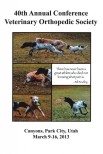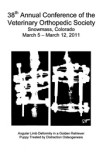Objective: The aim of this study was to develop and internally validate a machine-learning algorithm, PROSPECT (Predicting Risk Of Surgical complications aftEr CCWO and TPLO), using clinical variables to predict postoperative complications in dogs undergoing high tibial osteotomy for cranial cruciate ligament disease (CrCLD).
Study design: Retrospective multivariable prediction model development.
Sample population: Stifles (n = 670) and dogs (n = 555).
Methods: Complication data with a minimum follow up of 28 days were collected. Clinical variables were preprocessed for machine learning and interaction features were engineered. A multioutput eXtreme Gradient Boosting model was trained on 80% of the sample to predict minor, surgical, and medical complications independently. The trained PROSPECT model was then tested on the independent test set. Model performance was evaluated qualitatively and quantitatively.
Results: Complications occurred in 134/670 (20.0%) stifles, with 50 (7.5%) minor complications, 69 (10.3%) surgical complications, and 26 (3.4%) medical complications. The PROSPECT model achieved Brier scores and accuracies of 0.06379 ± 0.009100 and 91.9% for minor complications, 0.05481 ± 0.008589 and 92.3% for surgical complications, and 0.04102 ± 0.008194 and 94.3% for medical complications.
Conclusion: The PROSPECT model can predict postoperative complications accurately and in a probabilistic fashion following high tibial osteotomy for CrCLD.
Clinical significance: Machine learning may facilitate an individualized approach to risk management with the potential to enhance patient safety and promote safer surgery.









